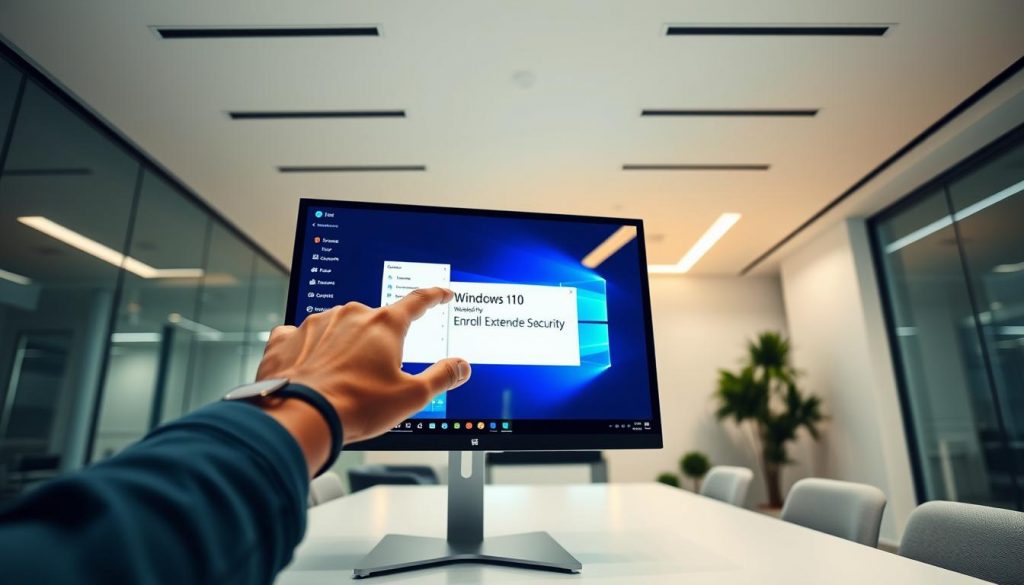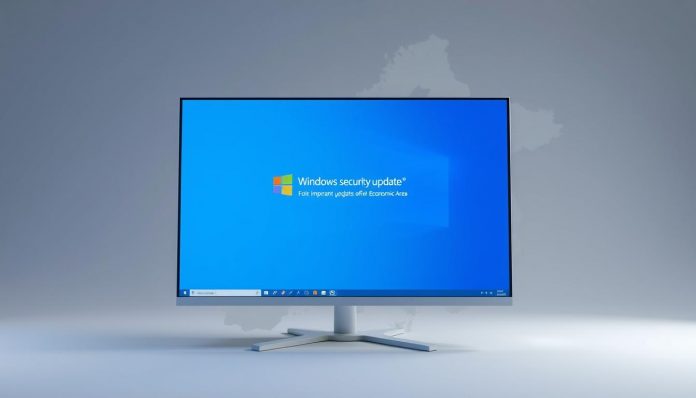Could a regulatory reprieve change the way millions of users receive security updates? The recent decision dubbed the Regulatory Reprieve EU is being hailed as a notable win for consumer protection and a rare retreat on enrolment rules.
Windows 10 reaches its end of support on 14 October 2025. In response, the company will offer no‑cost Extended Security Updates to consumer users in the European Economic Area without requiring Windows Backup or Microsoft Rewards. That concession follows pressure from Euroconsumers and shifts the post‑end landscape for many users of Windows PCs. As users consider how to upgrade Windows, this change is particularly significant.
Elsewhere, other markets must enable backup or pay a fee. Consumer ESU runs until 13 October 2026, so this is a temporary safeguard rather than a long‑term solution. The change highlights how jurisdiction shapes the update experience and what UK readers should weigh when planning upgrades.
Key Takeaways
- EEA consumers get no‑cost ESU until 13 October 2026, easing the immediate security gap after end of support.
- Non‑EEA users may face backup requirements or a fee to continue receiving updates.
- Euroconsumers played a central role in securing this concession on consumer choice and privacy.
- The reprieve is temporary; users should plan upgrades or enrolment before the 14 October 2025 end date.
- Read the full context and timeline in the related news report.
The Regulatory Reprieve EU: What Changed and Why It Matters
A recent EU intervention forced a major change to how extended security updates are delivered to consumers across the bloc. The move removes a prior enrolment hurdle and protects people who remain on older machines while they plan a move to newer systems.
EEA-only concession: free ESU without Windows Backup or Microsoft Rewards
In the European Economic Area, consumers can now enroll in extended security updates at no cost without enabling Windows backup or claiming Microsoft Rewards. Previously, the enrolment flow required a cloud backup that required a Microsoft Account and OneDrive, or else payment or reward‑point redemption.
Euroconsumers’ role and the pressure on Microsoft
Euroconsumers, a consumer advocacy group, argued that tying vital security updates to first‑party services ran counter to competition rules. That group pushed regulators to consider DMA Article 6(6) issues, prompting the change.
How this affects users still running Windows 10 across the EEA
The practical effect is straightforward: users in European economic contexts gain a streamlined path to security updates for their operating system version without enabling Windows backup or sacrificing privacy. Outside the EEA, consumers still face the backup flow, a yearly fee, or rewards‑point options related to the Microsoft 365 program.
Windows 10 End of Support in October 2025: Timelines, Risks, and Next Steps
14 October 2025 is the firm cut‑off date when mainstream servicing stops for the older desktop edition. After that date, the regular stream of security updates halts unless a device is enrolled in Extended Security Updates (ESU).
Key dates and what they mean
End support October falls on 14 October 2025. ESU coverage then provides important security updates until 13 October 2026.
Practical risks of no more patches
When security updates stop, newly found vulnerabilities receive no patches for non‑ESU systems. That increases the risk of malware, ransomware, and targeted exploits on devices that remain connected to the internet.
Next steps for users and IT managers
- Plan upgrades to Windows 11 or use cloud‑hosted Windows 11 via Windows 365 where hardware or flexibility demands it.
- Check apps, settings, and software for compatibility and prepare data transfer steps in advance.
- Note that ESU supplies security fixes only; it does not add features or long‑term OS support.
Act early: staying current with updates reduces exposure and keeps the device ecosystem healthier during the transition.
The Victory and the Digital Markets Act (DMA)
The DMA has emerged as a lever to prevent platforms from linking vital patches to other services. Regulators and consumer bodies raised concerns under Article 6(6) about conditioning access to extended security on first‑party features.
Why this matters: tying essential Windows security updates to backup or rewards risked reducing choice and creating lock‑in. The change decouples enrolment and treats updates as a distinct digital infrastructure.
Euroconsumers led a group action that flagged DMA Article 6(6) issues. As a result, the European economic enrolment process was adjusted to deliver a streamlined path to updates without mandatory backup activation.
| Issue | EEA response | Implication |
|---|---|---|
| Tying patches to services | Enrolment decoupled from backup | Greater consumer choice and less lock‑in |
| Access to extended security | Time‑limited ESU offered | Short bridge while users plan upgrades |
| Platform conduct signal | Regulatory scrutiny applied | Precedent for fair access to updates |
The result sends a clear signal across devices and software ecosystems: vital updates should not be contingent on ancillary services. Still, support under ESU is finite, so this regulatory victory is important but temporary.
The Critical Limitations: A Temporary Bridge, Not a Free Pass
Consumers gain a one‑year safety net, but significant limits and trade‑offs remain. The consumer extended security updates programme runs only until 13 October 2026, so this is a time‑bound measure rather than a long‑term guarantee.

Scope and duration
Extended security for consumer devices covers that single additional year. Organisations may purchase up to three years of paid support, but ordinary users have only a one‑year extension.
Outside the european economic area: costs and choices
Beyond the EEA, users must choose between three main routes: enabling Windows backup, paying a modest fee (about $30 per year), or redeeming 1,000 Microsoft rewards points. Enabling Windows backup typically requires a Microsoft Account and OneDrive, which some will not accept.
Security posture and residual risk
Even with security updates, residual risk persists. Patching reduces exposures, yet attackers evolve, and old components remain hard to rework.
“Extended security provides a necessary safety net, but it does not replace migration to modern, supported platforms.”
| Aspect | Consumer (EEA) | Consumer (non‑EEA) |
|---|---|---|
| Cost | No charge until Oct 2026 | Pay ≈$30 or redeem 1,000 points |
| Backup requirement | No enabling Windows backup required | Enabling Windows backup often required |
| Duration | 1 year (ends 13 Oct 2026) | 1 year for consumers; firms can buy up to 3 years |
Bottom line: Windows Extended Security is a finite, useful stopgap. Users should weigh cost, data, and control over backup choices and begin migration planning now to limit long‑term risk to apps, settings, and devices.
The UK’s Status: What Applies, What Doesn’t, and Why It Matters
UK consumers face a different pathway to extended security updates than their EEA neighbours. Because the UK sits outside the European Economic Area, the no‑cost ESU concession does not apply automatically to UK devices.
UK outside the EEA: no automatic free ESU reprieve
In practical terms, UK users who want ESU must either enable Windows Backup, pay roughly $30 a year, or redeem 1,000 Microsoft Rewards points. The consumer ESU period still ends on 13 October 2026, after the 14 October 2025 windows end support date.
Implications for technology news UK and consumer protection
Tech media in the UK will track how this divergence affects households and small firms running Windows. Coverage will focus on costs, enrolment friction, and risks for devices that process payments or hold personal data.
Policy debates may turn on whether UK regulators should align with the European Economic Area approach on access to essential security services. That discussion will shape consumer protection and future guidance.
- UK users must monitor Windows updates and pick an enrolment route or plan an upgrade.
- Running Windows without ESU raises tangible security risks; migration planning is sensible.
- Clear, local tech guidance will be vital so users understand options and timelines.
“Regional rule differences will shape costs, user choice, and how quickly people move to supported platforms.”
How Enrollment Works Now: Updates, Backup, Rewards, and Requirements
Enrolment paths now differ sharply by region, with the EEA receiving a simpler route to extended protection. The change means EEA consumers can enroll in extended security without the prior requirement to enable Windows backup or redeem rewards.

EEA process: a streamlined experience without enabling Windows Backup
In the EEA the process is streamlined to remove the backup gate. Consumers follow a guided enrolment flow that focuses on identity and device eligibility, rather than forcing cloud backup activation.
Account, apps, settings, and data considerations
Outside the EEA, the usual choices remain: enable the backup flow (which typically requires a Microsoft Account and OneDrive), pay an annual fee of about $30, or redeem 1,000 rewards points.
Before enrolling, users should review apps and settings to check compatibility. They should confirm that critical applications still receive vendor support and plan any data migration.
- Document credentials: keep account and backup plans recorded.
- Verify patches: confirm enrolment status and that important security updates install correctly.
- Check restarts: schedule times for reboots so patches apply without disrupting work.
Extended security aims to preserve a safety baseline via security updates microsoft, not to add new OS features.
Market Pulse: Technology Industry Insights and Tech Finance News
Market signals show a rapid shift in corporate procurement as newer platform adoption accelerates across the region.
Upgrade trajectories and enterprise ESU purchasing
Adoption data from public trackers and vendor reports show an uptick in migration to the latest desktop edition and cloud options such as Windows 365. Large organisations buy enterprise ESU for up to three years to smooth complex estate transitions.
Signals for IT and tech industry trends
As more customers migrate, vendors focus support, drivers, and optimisation on newer releases. That shift appears in procurement plans and in tech finance news, where budgets move from licence line items to platform modernisation.
Cost‑benefit for customers across the european economic area
Organisations weigh ESU costs against refresh cycles. Older devices may run critical apps but carry hidden risk. Spreading refresh costs or using cloud desktops helps manage cashflow and sustainability goals.
“Upgrading sooner often reduces cumulative cyber risk and unlocks modern security capabilities.”
| Consideration | Short term | Medium term |
|---|---|---|
| Security posture | ESU provides patches | New releases improve protection |
| Cost | ESU or per‑device fee | CapEx refresh or cloud Opex |
| Apps & compatibility | May need testing | Better support and optimisation |
What Happens After October 2026?
After October 2026, consumer devices will no longer receive official security fixes through a Windows update unless they move to a supported path. That end date closes the temporary safety net provided by consumer ESU and means systems running older desktop software face increasing exposure.
Paths forward
Migrate to Windows 11: upgrading on compatible hardware keeps devices current and restores full support, improved protections, and a better management experience.
Adopt Windows 365: cloud‑hosted desktops shift workloads off legacy machines and reduce local attack surface, useful where hardware replacement is costly.
Contain legacy devices: some users may isolate critical legacy machines on segmented networks, apply strict access controls, and restrict internet access to lower risk.
Advocacy and vendor stance
Consumer groups may press for further concessions, especially for vulnerable cohorts. However, the vendor has signalled that long‑term strategy targets migration to supported releases rather than repeated consumer extensions.
“Extending consumer ESU repeatedly reduces pressure to modernise and risks leaving larger numbers of devices insecure.”
Organisations and households should run pragmatic risk assessments on apps, devices and software dependencies. Treat the ESU end as a firm planning deadline that aligns budgets, timelines and stakeholder communications.
| Choice | Benefits | Drawbacks |
|---|---|---|
| Upgrade to modern release | Full support, better protection, improved performance | Hardware or licence costs, testing work |
| Cloud desktop (Windows 365) | Reduced local patching, easier management | Recurring cost, network dependency |
| Containment/isolation | Buys time, reduces exposure for niche apps | Operational limits, not a long‑term fix |
Plan early: begin data migration and validation steps now, prioritise critical workloads, and remember that skipping upgrades raises cumulative risk over the coming years.
Will Microsoft Keep Windows 10 Free for Europe? Find Out Now
A temporary enrollment path now lets many users receive essential patches without mandatory cloud backup.
The outlook from now to EOS and beyond
Short term: consumers in the European Economic Area may enrol in consumer ESU without enabling backup or redeeming rewards. This concession runs through the ESU window and covers important security updates until 13 October 2026.
Milestones: Windows end support occurs on 14 October 2025, then ESU provides a final year of security fixes only. After 13 October 2026, devices must be on a supported platform to receive further updates.
Market signal: the vendor aims to steer customers toward newer releases, so the EEA concession is unlikely to become permanent. UK and other markets remain on the enrolment option that requires backup, payment or points.
“Treat ESU as a short‑term safety net while planning timely upgrades for devices, software, and apps.”
- Use the concession while it lasts, but plan upgrades early.
- Remember ESU supplies security patches, not feature updates.
- Assess device and app compatibility now to avoid last‑minute disruption.
Conclusion: Will Microsoft Keep Windows 10 Free for Europe? Find Out Now
Regulatory pressure produced a narrower but important concession that eases access to post‑support patches in the EEA. The EEA enrolment change gives consumers a no‑cost ESU without needing Windows backup or redeeming Microsoft rewards points until 13 October 2026, ensuring that home users can continue to benefit from essential Windows updates.
UK readers remain outside that scheme and should plan now. They can enable windows backup, pay the annual fee, or use microsoft rewards points to keep receiving security updates microsoft during the ESU window, especially for their home devices.
Key action points: treat ESU as a runway, document settings and apps, and schedule an upgrade to a supported release or a cloud desktop. The DMA themes behind this case show how separating essential patches from tied services can protect users without weakening security.
Dates to note: end support is 14 October 2025; consumer ESU ends 13 October 2026. Act promptly to reduce risk and follow UK and EEA tech news for any further policy changes.
For more Big Tech and Technology Articles, please follow the link.


